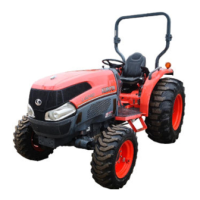PERIODIC SERVICE84
A Do not permit dirt or trash to get into the fuel system.
A Be careful not to let the fuel tank become empty,
otherwise air will enter the fuel system, necessitating
bleeding before next engine start.
A Be careful not to spill during refueling. If should spill,
wipe it off at once, or it may cause a fire.
A To prevent condensation (water) accumulation in the
fuel tank, fill the tank before parking overnight.
A No.2-D is a distillate fuel of lower volatility for engines
in industrial and heavy mobile service.
(SAE J313 JUN87)
A Grade of Diesel Fuel Oil According to ASTM D975
BChecking Engine Oil Level
To avoid personal injury:
A Be sure to stop the engine before checking the
oil level.
1. Park the machine on a flat surface.
2. Check engine oil before starting the engine or 5
minutes or more after the engine has stopped.
3. To check the oil level, draw out the dipstick, wipe it
clean, replace it, and draw it out again. Check to see
that the oil level lies between the two notches.
If the level is too low, add new oil to the prescribed
level at the oil inlet.
(See "LUBRICANTS" in "MAINTENANCE" section.)
A When using an oil of different maker or viscosity from
the previous one, remove all of the old oil.
Never mix two different types of oil.
A If oil level is low, do not run engine.
Fuel tank
capacity
L3240, L3540 44L (11.6 U.S.gals.)
L3940, L4240 50 L (13.2 U.S.gals.)
L4740, L5040,
L5240, L5740
54 L (14.3 U.S.gals.)
Flash Point,
()
Water and
Sediment,
volume
%
Carbon
Residue on,
10 percent
Residuum, %
Ash, weight
%
Min Max Max Max
52 (125) 0.05 0.35 0.01
Distillation
Tempera-
tures,
()
90% Point
Viscosity
Kinematic
cSt or
mm /s
at 40
Viscosity
Saybolt,
SUS
at 100
Sulfur
weight
%
Cop-
per
Strip
Corro-
sion
Ce-
tane
Num-
ber
Min Max Min Max Min Max Max Max Min
282
(540)
338
(640)
1.9 4.1 32.6 40.1 0.50 No.3 40
(1) Oil inlet
(2) Dipstick
(A) Oil level is acceptable within this range.

